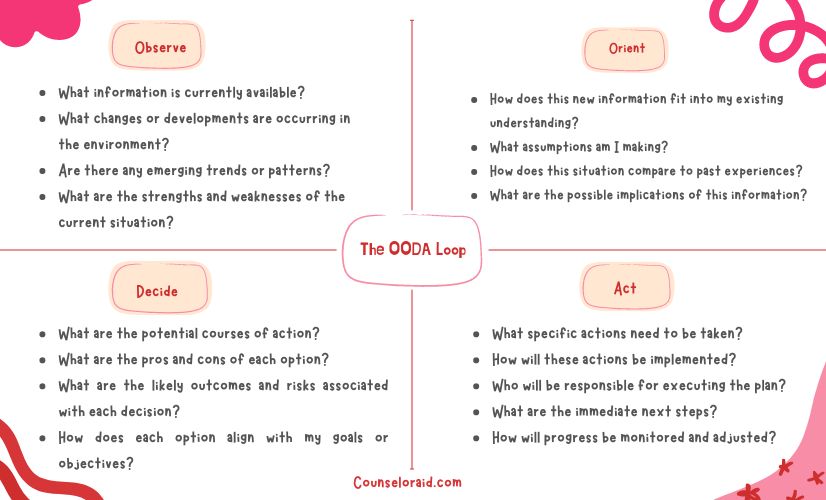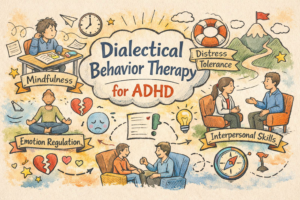Critical thinking, situational awareness, and rapid decision-making are essential for maintaining a strategic advantage in highly competitive and dynamic environments. For example, in a military operations, emerging intelligence is utilized effectively for planning and operations, likewise, corporate strategies need a practical information processing framework to succeed at the cost of someone’s failure. One of the most effective frameworks for navigating uncertainty and sustaining a competitive edge is the OODA Loop.
Originally developed for military strategy, the OODA Loop has applications in various fields, including business, sports, and personal development. Built on the four continuous stages — Observe, Orient, Decide, and Act —this model is a widely used tool for enhancing critical thinking, decision-making, and situational awareness.
What is the OODA Loop?
The OODA Loop’s four-step decision-making framework emphasizes filtering available information, applying it to context, and utilizing it to make swift decisions with the flexibility to change as new data emerges. This strategy is effective for individuals and organizations, particularly in competitive environments where the ability to respond to evolving circumstances faster than an opponent provides a significant advantage.
The OODA was first conceived by John Boyd, a former United States Air Force fighter pilot and renowned military strategist. Boyd developed the tool to help other military strategists make critical decisions. Used initially in combat, the OODA Loop has evolved into a valuable tool used in various fields that require critical decision-making skills, including business.
According to Boyd, an individual capable of applying the OODA cycle rapidly for instant decision-making quickly infiltrates another’s operational cycle for a strategic advantage. The result could then be used to defeat an enemy in combat.
The Four Core Elements of the OODA Loop
Although John Boyd’s original OODA model was multidimensional and interconnected, modern applications — particularly in business and cognitive science — focus on the four primary stages of the OODA Loop: Observe, Orient, Decide, and Act. Together, these components form a continuous cycle that enhances perception, analysis, adaptability, and responsive action in dynamic environments
1. Observe (Perception and Data Acquisition)
The first step involves gathering information from one’s environment in order to collect relevant data, identifying key variables, and recognizing changes and patterns. Observing includes surveillance, reconnaissance, data collection, and monitoring current conditions and trends.
In today’s context, observing can be defined as identifying a problem and better understanding its internal and external environment. This is like data collection of metrics and insights into an organization’s status, market competition, market trends, evolving trends, and human resources. Recognizing that emerging data can change at times, strategists should base their decisions quickly to remain one step ahead.
2. Orient (Analysis and Cognitive Processing)
The Orient phase is the most cognitively intensive and influential step in the OODA Loop. This aims to analyze and synthesize the information to understand the situation, anticipate future states, and determine potential courses of action.
This stage incorporates:
- Contextual analysis
- Pattern recognition
- Cultural and organisational perspectives
- Awareness of cognitive biases
- Application of prior knowledge and experience.
In practical terms, the orient phase includes insight, analysis, planning, and decisiveness. It requires deep consideration of why decisions must be made before action.
Use the Orientation phase to create mental models using current information and apply them to narratives for judgment and decision-making. Organizations can use machine learning tools to identify potential scenarios, create narratives, and remove all biases to clarify a situation.
3. Decide (Strategic Selection of Action)
This step involves selecting the best course of action based on the orientation phase. Its purpose is to make an informed, timely decision that aligns with strategic objectives and situational demands. Deciding requires evaluating alternatives, risk assessment, prioritizing actions, and making decisions under uncertainty.
When applied to organizational strategy, the Decide phase uses insights from the earlier stages to suggest courses of action and response, considering various potential outcomes. The process requires team discussions to develop an organizational roadmap.
4. Act (Execution and Adaptive Response)
ACT or the final step is implementing the chosen course of action. ACT helps execute decisions swiftly and effectively, followed by monitoring the results to feed back into the observation phase. It involves action implementation, performance tracking, adjusting actions as needed, and maintaining flexibility to adapt to new information. It also includes testing and changes that might be necessary to respond to the decisions. In effect, the Act involves executing a decision and testing if a hypothesis is correct. Since OODA is a loop, there is always a last step. Instead, the validity of a theory is carried over into the next cycle of the Loop as a repetitive process to ensure more accuracy and speed.
The Benefits of the OODA Loop
The OODA Loop offers several key benefits that contribute to its widespread adoption across various fields:
- Enhanced Situational Awareness: By continuously observing and orienting, individuals and organizations can maintain a high level of situational awareness. This helps promptly identify emerging threats and opportunities.
- Improved Decision-Making: The iterative nature of the OODA Loop encourages constant reassessment and adjustment, leading to more informed and effective decisions. This adaptability is crucial in dynamic and uncertain environments.
- Increased Agility and Speed: The emphasis on rapid decision-making and action allows users to stay ahead of competitors or adversaries. This agility is particularly valuable in competitive fields where time is of the essence.
- Proactive Problem-Solving: The OODA Loop fosters a proactive approach to problem-solving. Individuals and organizations can mitigate risks and respond effectively to challenges by anticipating potential issues and planning accordingly.
- Resilience and Adaptability: The continuous feedback loop of the OODA model promotes resilience and flexibility. Users can quickly adapt to changing circumstances, learning from successes and failures to refine their strategies.
How to Apply the OODA Loop for Critical Thinking, Decision-Making, and Situational Awareness
The OODA Loop has become valuable in various fields, including business, game theory, information security, law enforcement, litigation, marketing, and military strategy. Professionals prefer the framework because of its logical approach which helps them stay abreast of competition. Organizations implementing OODA Loop principles often incorporate its cyclical logo or visual representation in training materials to reinforce the continuous nature of observe-orient-decide-act cycles.
OODA Loop for Critical Thinking
In critical thinking, observe by collecting diverse sources of information and evidence before making judgments. Seek different perspectives and consider cognitive biases and influences to analyze and synthesize information. Use analytical tools and frameworks to understand complex situations and evaluate the alternatives based on logical reasoning and evidence. Prioritize decisions that align with long-term goals and values. Once these three phases provide the required data and potential situations, decisions will be implemented to monitor outcomes and adjust strategies as needed. Consistently reflect on the decision-making process to improve future performance.
OODA Loop in Decision-Making Processes
Use resources such as technology and tools to maintain a constant flow of relevant data to inform decision-making. Analyze the data to create mental models and scenarios to anticipate possible futures. Perform team exercises to create scenarios, plans, and stress tests to evaluate the validity of decisions. Develop criteria for decision-making that include risk tolerance, resource availability, and strategic objectives. Once a clear plan is created, execute decisions, ensuring roles and responsibilities are defined. Establish ways and means to generate feedback and adjustment.
OODA Loop and the Development of Situational Awareness
Focus on internal and external environmental changes. Use real-time monitoring systems and situational reports to stay informed. Consider historical data, trends, and patterns. Leverage expertise and experience to interpret information accurately. During the decision-making phase, decisions should be responsive to the current situation with flexibility for change. Action should be decisive and alert to new emerging data that might require a change in strategy.
Conclusion
The OODA Loop is a robust framework that has evolved from its military origins to being a valuable and insightful tool in several industrial fields. It helps individuals and organizations with a structured yet flexible approach to navigating complex challenges. This leads to more effective and resilient decision-making processes for productivity and growth.





